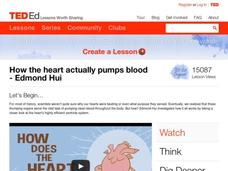SciShow
Do You Have a Maximum Heart Rate?
Does your heart rate have an upper limit and could you ever reach it?
SciShow
Do You Have a Maximum Heart Rate?
Does your heart rate have an upper limit and could you ever reach it?
SciShow Kids
How to Feel Your Heart Beat
Get to know your body’s most important muscle -- your heart -- and learn how to take your own pulse!
Curated Video
Why does your heart beat?
Your heart is a pump that pushes blood all around your body. Living things - My incredible body - My heart Learning Points Your heart is like a pump – it pushes blood around your body every time it beats. A Twig Junior Film - Core...
Curated Video
Rhythm Basics: How To Play Longer Rhythms - Half Notes, Dotted Half Notes, Whole Notes
Our Rhythm Basics series continues with a new video that goes over how to read, understand, and play longer rhythmic patterns. In this third installment of the series, Nathan breaks down Half Notes, Dotted Half Notes, and Whole Notes....
Curated Video
The ECG Song (R&B) - How to Read an ECG/EKG
Today, I'm diving deep into the magic of the ECG, and trust me, it's like music to my ears—literally. As someone who's always been fascinated by the way our body works, I'm taking you on a lyrical journey through the electrical symphony...
Curated Video
How the Heart Contracts - Step by Step
Let's dive into the cardiac action potential and how it results in the contraction of the heart. We'll talk about the signal that starts at the SA node and spreads throughout the heart. We'll also get into the phases of depolarization,...
Curated Video
How to Read an Electrocardiogram (ECG/EKG)
Making Biology Fun. In this video, I go through the P wave, QRS complex, T and U waves of the Electrocardiagram and go into the details of what each of them represents. Enjoy!
Curated Video
What Stroke Volume is and How to Calculate it
In this video, I talk about what stroke Volume is - the difference between end-diastolic volume and end-systolic volume. SV = EDV-ESV. Enjoy!
Curated Video
The Pacemaker Potential of the SA Node and the AV Node
In this episode, I talk about how the Pacemaker Potential results in the signal that causes the heart to beat. I show how the greater conductance for Sodium ions in the Pacemaker Cells in the S.A. Node cause the cells to depolarize,...
TED-Ed
How the Heart Actually Pumps Blood
Let your heart rejoice! A unique video explains in detail how the heart works to transport blood throughout the human body. Use it during your human body unit, and then discuss the accompanying comprehension questions as a review of the...
Curated OER
My Cute Little Heart Beat
Grover discusses the heart in this short video. He uses a stethoscope to listen to his heartbeat and discusses the positive effects of exercise.
Howard Hughes Medical Institute
Hhmi: Bio Interactive: The Cardiology Lab
A fascinating interactive laboratory in which simulations allow students to explore techniques of cardiac diagnosis and learn about cardiac structure/function. Excellent supporting information and resources for teachers and students.
Khan Academy
Khan Academy: Heart Introduction: Lub Dub
Ever wonder why the heart sounds the way that it does? Opening and closing of heart valves makes the heart rhythm come alive with its lub dub beats. Rishi is a pediatric infectious disease physician and works at Khan Academy. [9:50]
Sophia Learning
Sophia: Cardiac Cycle and Cardiac Conduction System
This lesson will explain the steps that occur when your heart muscle contracts. It will investigate the cardiac cycle and the cardiac conduction system. It is 1 of 2 in the series.





